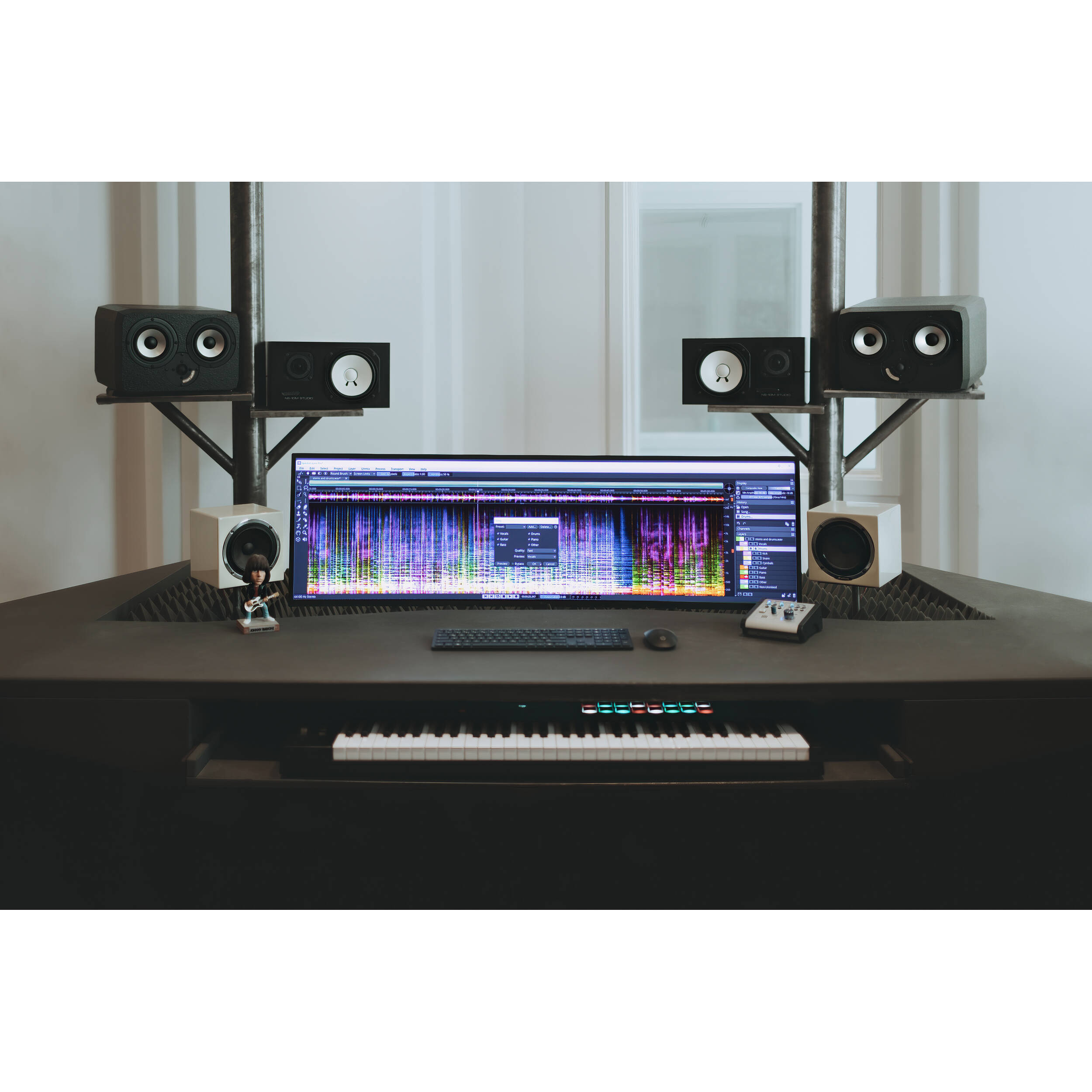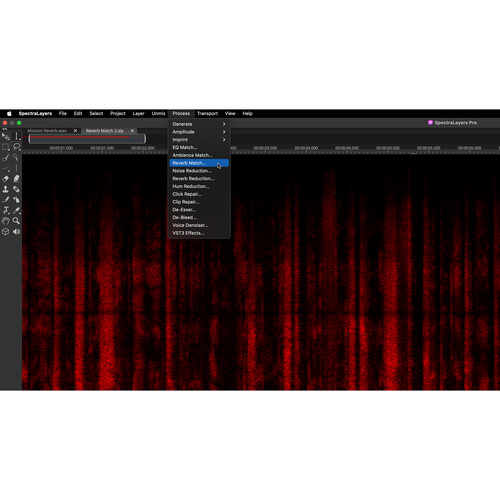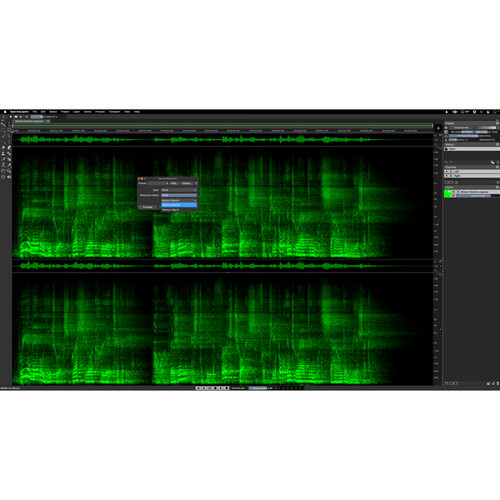Steinberg 91683 Overview
offers audio engineers a powerful set of tools to visually manipulate and process audio for a variety of purposes including noise reduction, audio extraction, repair and restoration, and sound sculpting. This latest iteration of the software has been reinvented from the ground up with all-new state-of-the art AI systems, which establish new benchmarks for precision, speed, and control. New tools and processes provide unmatched levels of power for editors in every field repair, postproduction, mastering, music production, and 21st century sound design.
At the core of SpectraLayers is the spectrograph display that allows you to easily visualize and process audio events. You can explore, reach in, take, and transform, working wonders on tasks ranging from repairing and restoring audio to freeform sound design. Unmatched selection tools developed over many years are now joined by new artificial-intelligence-driven audio extraction and repair processes, making this the most significant version of SpectraLayers yet. Thanks to advanced ARA 2 technology, which is designed to build bridges between audio editing applications, SpectraLayers can be launched inside Nuendo, Cubase, and other compatible host applications to provide comprehensive nondestructive visual editing right on the DAW timeline. SpectraLayers Pro 10 is ready for heavy-duty professional applications supporting up to eight channels of audio at a maximum sampling rate of 384 kHz.
What s New in Version 10
Unmix Your World
Unmixing in SpectraLayers 10 has been radically restructured and expanded. Capture more instruments, including guitar tracks and drum hits. Unmix multiple voices into their own independent layers, unmix multichannel content, selected time ranges, and employ a variety of new processes tailored to your unmixing objectives.
Song Unmixing
- The stem unmixing process now adds guitar, for a total of six generated layers. New controls allow you to perform the unmixing process in various ways to best suit your source material.
Unmix Drums
- After unmixing a track into six stems, you can now apply a dedicated unmix process to the drums layer alone, to acquire clean kick, snare and cymbals layers.
Unmix Multichannel Content
- Select a small portion of a specific sound, engage Unmix Multichannel Content to analyze its relative power across multiple channels and then extract the entire sound evenly across them all.
Unmix Multiple Voices
- Use Unmix Multiple Voices to extract two or more voices to their own independent layers. A discrimination control is provided to help optimize the process for given sources.
Unmix Noisy Speech
- Separate speech from background noise with a new AI-assisted process specifically trained on human speech. Every noise reduction algorithm in SpectraLayers 10 has been upgraded.
Other Improvements
Every AI-assisted process has been updated. Achieve better-sounding results when unmixing music and sound, and also when making corrections using the Reverb Reduction and Voice Denoiser processes.
Speech Processing and Refinement
Postproduction specialists will be pleased with the new approaches taken to speech recognition and processing. New features and reenergized legacy features come together here on a platform with immense power for shaping dialog. ARA integration with Nuendo and Cubase seals the deal.
Transcription
Speech layers can now be transcribed into nine different languages, with words, phrases, and sentences conveniently listed and visible on the timeline for easy selection and editing.
Reverb Match Process
Reverb Match now partners with Ambience Match, EQ Match, and the improved Reverb Reduction process, to provide a new level of ambient space control.
More Processes, More Control
On top of the redesigned core and vastly evolved AI potential, Steinberg added a host of new features for enhanced control. Classify sounds by type, identify competing sounds, set spectral thresholds, normalize at the layer level, and take advantage of many other new features for a truly enhanced editing experience.
Logical Layer Colors
- As well as new options to create more automatically generated layers, there are new ways to stay organized. This improvement helps ensure that your layers will default to alternating colors.
Improved Value Sliders
- Another small workflow improvement is that Steinberg improved the feel of every slider in the application, to help you get to the settings you need as smoothly and effortlessly as possible.
Preview and Apply Keyboard Shortcuts
- These new shortcuts help you to take advantage of more options for getting things done in SpectraLayers in ways that best suit your workflow.
Time Insert / Cropping
- New insert and cropping options allow you to use these operations on a per-layer basis, as opposed to making changes across all layers of a project.
Contextual Cut/Copy/Paste
- Yet another way to keep your eyes on the prize: perform cut/copy/paste operations by simply right-clicking over your selection and accessing this new menu.
Improved Online Help
- Every tool and process now links directly to its user guide page. Learn as you explore the program and enhance your understanding as you work.
Multiple VST3 Plug-In Support
- Now you can chain multiple plug-ins in the VST3 effects process. In conjunction with the new selection-based processing, this provides greatly expanded and more precisely-targeted plug-in processing options.
View Multiple Processes At-Once
- Expanding on the Dynamic Spectral Processing functionality, now you can have multiple process dialogs open at once. Toggle between them to evaluate the differences between selected processes.
Import Multiple Audio Files At-Once
- Launch a new SpectraLayers project or add layers to an existing project quickly by importing multiple audio files at once. Each will appear on its own independent layer.
Features
General
3D Perspective
- This is a simple repair tool used for bridging unwanted gaps in frequencies displayed on the spectral graph. Hover over a target frequency, click-drag across the gap, then release the control on the other side to create a reconstructed frequency. This is one tool of many, in an open system with unlimited possibilities for post and restoration work, music production and sound design, audio mastering and audio forensics. Visualization, layering, processing, tooling SpectraLayers has it all.
Layers Panel
- Layers are comparable to DAW tracks. Here we have control over levels, mute/solo status, and phase. Mix, merge, change the order, apply colors layers are at the heart of what makes SpectraLayers so unique. In ARA mode in Cubase and Nuendo, you can create layers and drag them directly into the arrange window new audio files are automatically created in the Pool. This functionality is a program integration benchmark that makes the ARA workflow so essential.
Display Panel
- These controls are like the focus and aperture controls on a camera. You can sharpen the image, adjust for brightness (a function of amplitude). and choose the best FFT size for the task. By default, layers are differentiated by color in the spectral graph. Switch to Composite View mode and all active layers are displayed in your choice of nine unique color maps, with dynamic tinting that provides a clear visual depiction of the dynamic range interactions between layers.
ARA Implementation
- ARA 2 technology builds bridges between audio editing applications. Launch SpectraLayers directly into the Cubase/Nuendo project window for the ultimate in real-time program integration. Drag and drop layers direc
In the Box
- Steinberg SpectraLayers Pro 10 Audio Repair and Restoration Software
No posts found





























